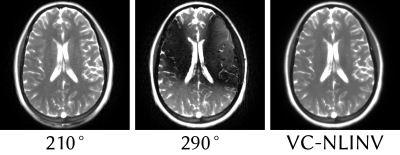2870
Banding-Free Reconstruction in Frequency-Modulated bSSFP using Virtual Coils with Regularized Non-Linear Inversion1Department of Diagnostic and Interventional Radiology, University Medical Center Göttingen, Göttingen, Germany, 2Partner Site Göttingen, German Center for Cardiovascular Research (DZHK), Göttingen, Germany
Synopsis
We propose a method for banding-free reconstruction of bSSFP images using Regularized Non-Linear Inversion (NLINV). Instead of using only a few different phase cycles, we dynamically change the phase cycle in each frame, which only slightly changes the steady state. By stacking all frames together as virtual coils and using NLINV, images free of banding artifacts can be reconstructed. Since no new steady states need to be prepared, dead time is eliminated from the acquisition.
Introduction
Balanced steady-state free precession is a fast MRI sequence offering high SNR and a unique T₂/T₁ contrast, but it suffers from banding artifacts. RF phase cycling can be performed to mitigate these artifacts, but only at the cost of additional scan time. Joint reconstruction methods as presented by Ilicak et al.¹ and Bilgic et al.² can decrease this additional scan time. Still, each phase cycle (typically between 4 and 8) needs to be performed in a new steady state, which necessitates a recovery period between acquired cycles and a setup period into the new steady state. Here, we propose a method which adjusts the RF phase increment in each frame, effectively creating a new phase cycle in each frame. This leads to a method close to frequency-modulated (or dynamically phase-cycled) bSSFP³,⁴. Similar to the joint reconstruction approaches, we stack the dynamic phase cycles in the coil dimension, treating different phase cycles as additional virtual coils. The resulting problem is solved using Regularized Non-Linear Inversion (NLINV)⁵. This method is termed virtual-coil-NLINV (VC-NLINV).
Methods
We acquired frequency-modulated bSSFP data of a transversal slice through the brain of a volunteer with no known illnesses. Sequence parameters were: TR/TE: 4.4ms/2.2ms, flip angle: 40°, FOV: 192x192mm², resolution: 1x1x5mm³, bandwidth per pixel: 840 Hz. We recorded 2 datasets: a) 2° phase increment and 43 spokes per frame, and b) with 5° phase increment and 17 spokes per frame. Each dataset contains frames covering phase cycles between 180° and 360°, leading to acquisition times of a) 17.0s for 90 frames and b) 2.7s for 36 frames.
These data were then reconstructed, once using real-time NLINV⁶ to visualize the individual phase cycles, and again using the proposed VC-NLINV, where all frames are stacked as virtual coils. All reconstructions were done using the Berkeley Advanced Reconstruction Toolbox (BART)⁷.
Results
The reconstructions using VC-NLINV, together with selected individual phase cycles, are shown in Fig. 1 for dataset a) and in Fig. 2 for dataset b). In both cases, the banding artifacts visible in the individual phase cycles are eliminated using VC-NLINV. Using only 17 spokes (Fig. 2) leads to residual streak artifacts in the images. Using 43 spokes, no streak artifacts are visible (Fig. 1).Discussion
Using VC-NLINV, the bSSFP banding artifacts can be suppressed. However, for few spokes, residual streak artifacts remain.
Since the RF phase increment is only changed by a small amount in each frame, the steady state is only slightly disturbed³. Therefore, the individual frames can be treated as different phase cycles, each with a slightly different phase increment. This, of course, only slightly moves the banding artifacts. Therefore, compared to traditional phase cycling which typically uses less than 10 cycles, a much larger number of frames must be combined in this method. However, an advantage of the proposed acquisition scheme is that it can be done continuously without preparing a new steady state for each cycle.
Currently, we used 5 sets of uniformly distributed radial spokes which then repeat every 5 frames. Changing this to acquiring a new set of spokes in each frame, for example by using the golden angle between spokes, might improve image quality.
Conclusion
Here, we propose a method for suppressing banding artifacts in bSSFP imaging by dynamically changing the phase cycle in each frame. Treating the different frames as virtual coils leads to a reconstruction problem which is solved using NLINV. Together, banding-free bSSFP images can be acquired in less than 3 seconds.Acknowledgements
No acknowledgement found.References
[1]: E. Ilicak et al., MRM 78:1316–1329 (2017).
[2]: B. Bilgic et al., ISMRM 25:0441 (2017).
[3]: D. Foxall, MRM 48:502–508 (2002).
[4]: T. Benkert et al., MRM 73:182–194 (2015).
[5]: M. Uecker et al., MRM 60:674–682 (2008).
[6]: M. Uecker et al., NMR Biomed 23:986–994 (2010).
[7]: M. Uecker et al., ISMRM 23:2486 (2015).
Figures

